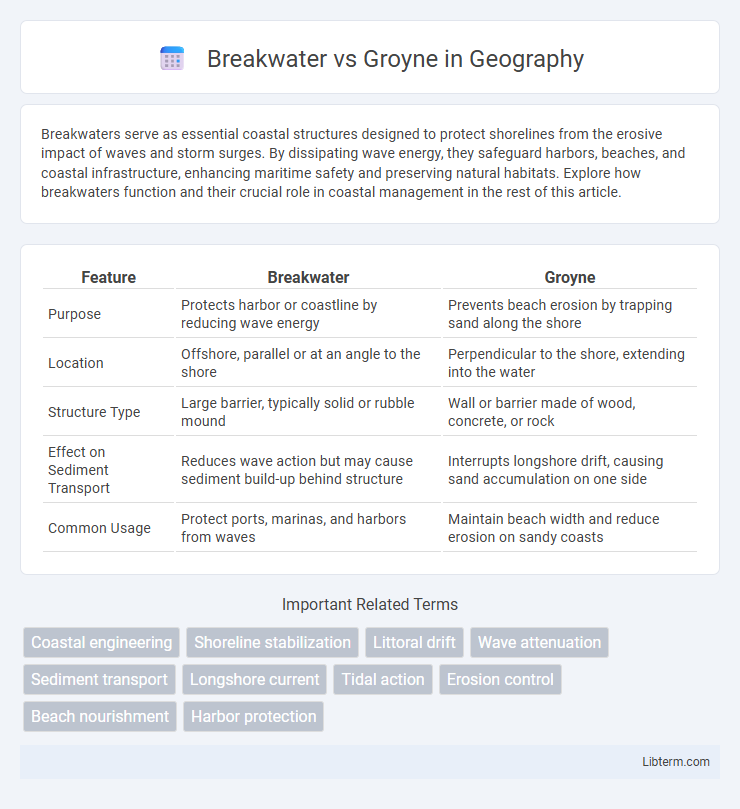Breakwaters serve as essential coastal structures designed to protect shorelines from the erosive impact of waves and storm surges. By dissipating wave energy, they safeguard harbors, beaches, and coastal infrastructure, enhancing maritime safety and preserving natural habitats. Explore how breakwaters function and their crucial role in coastal management in the rest of this article.
Table of Comparison
| Feature | Breakwater | Groyne |
|---|---|---|
| Purpose | Protects harbor or coastline by reducing wave energy | Prevents beach erosion by trapping sand along the shore |
| Location | Offshore, parallel or at an angle to the shore | Perpendicular to the shore, extending into the water |
| Structure Type | Large barrier, typically solid or rubble mound | Wall or barrier made of wood, concrete, or rock |
| Effect on Sediment Transport | Reduces wave action but may cause sediment build-up behind structure | Interrupts longshore drift, causing sand accumulation on one side |
| Common Usage | Protect ports, marinas, and harbors from waves | Maintain beach width and reduce erosion on sandy coasts |
Introduction to Coastal Protection Structures
Breakwaters and groynes are essential coastal protection structures designed to prevent erosion and mitigate wave impact. Breakwaters are offshore barriers that absorb wave energy and create calm water zones, protecting harbors and shorelines. Groynes, built perpendicular to the coastline, trap sediment transported by longshore drift, promoting beach accretion and reducing shoreline retreat.
What is a Breakwater?
A breakwater is a coastal structure designed to protect shorelines and harbors from the force of waves by reducing wave energy before it reaches the shore. Constructed offshore, breakwaters can be either fixed or floating and are typically made from large rocks, concrete, or other durable materials to absorb and deflect wave impact. Unlike groynes, which extend perpendicular to the shore to prevent sediment erosion, breakwaters primarily serve as barriers that create calm waters for safe anchorage and beach protection.
What is a Groyne?
A groyne is a coastal engineering structure built perpendicular to the shoreline, designed to trap sand moved by longshore drift and prevent beach erosion. Typically constructed from wood, concrete, or rock, groynes extend from the beach into the water, disrupting sediment flow and promoting beach accretion on their updrift side. Unlike breakwaters, which are offshore barriers that reduce wave energy, groynes directly manage sediment distribution along the coast to maintain and stabilize the beach.
Key Differences Between Breakwaters and Groynes
Breakwaters are offshore structures designed to protect harbors and coastlines from wave action by absorbing and deflecting energy, while groynes are shore-perpendicular barriers aimed at trapping and accumulating sediment to prevent beach erosion. Breakwaters typically extend parallel to the shoreline and create calm water areas behind them, whereas groynes disrupt longshore sediment transport by interrupting sand movement along the coast. The primary difference lies in their function: breakwaters reduce wave intensity for navigation safety, and groynes manage sediment flow to maintain beach stability.
Functions and Purposes of Breakwaters
Breakwaters serve primarily to protect coastal areas from the force of waves, reducing erosion and creating calm waters for safe harbors and recreational activities. Unlike groynes, which trap sand and prevent longshore drift to build up beaches, breakwaters act as barriers placed offshore to absorb and deflect wave energy before it reaches the shore. This function is critical in preventing coastal damage, promoting sediment deposition in sheltered areas, and supporting marine infrastructure stability.
Functions and Purposes of Groynes
Groynes are coastal structures built perpendicular to the shoreline to interrupt water flow and limit sediment transport, thereby reducing beach erosion and promoting sand accumulation. Their primary function is to trap sand moving along the coast via longshore drift, helping to widen beaches and protect the shore from wave action. Unlike breakwaters, which are offshore barriers designed mainly to dissipate wave energy before it reaches the shore, groynes focus on stabilizing the beach profile through sediment retention.
Advantages of Breakwaters
Breakwaters provide superior coastal protection by dissipating wave energy before it reaches the shore, significantly reducing erosion and preventing flooding in vulnerable areas. Unlike groynes, breakwaters create calmer water conditions behind them, promoting sediment deposition and enhancing beach stability. Their ability to protect harbors and support marine ecosystems makes breakwaters an effective solution for long-term shoreline management.
Advantages of Groynes
Groynes effectively reduce beach erosion by trapping and accumulating sand along the shoreline, promoting beach stability and expansion. They require lower construction costs and maintenance compared to breakwaters, making them a cost-efficient solution for coastal protection. Groynes also enhance local ecosystems by creating calm, sediment-rich environments favorable for marine life and vegetation growth.
Environmental Impacts of Breakwaters vs Groynes
Breakwaters reduce wave energy more effectively than groynes, leading to significant changes in sediment transport and potential erosion downstream of their placement. Groynes interrupt longshore drift by trapping sediment, which can cause accretion on the updrift side but result in sediment starvation and increased erosion on the downdrift side. Both structures impact coastal habitats, but breakwaters tend to create more extensive changes in water flow and sediment deposition patterns, affecting marine ecosystems differently than groynes.
Choosing the Right Solution: Breakwater or Groyne?
Choosing between a breakwater and a groyne depends on coastal protection needs and sediment management goals. Breakwaters are offshore structures designed to absorb wave energy, reducing erosion and protecting harbors, while groynes are shore-perpendicular barriers aimed at trapping sand to build up beaches. Evaluating factors like wave intensity, sediment transport patterns, and long-term maintenance costs ensures the optimal solution for stability and environmental impact.
Breakwater Infographic

 libterm.com
libterm.com